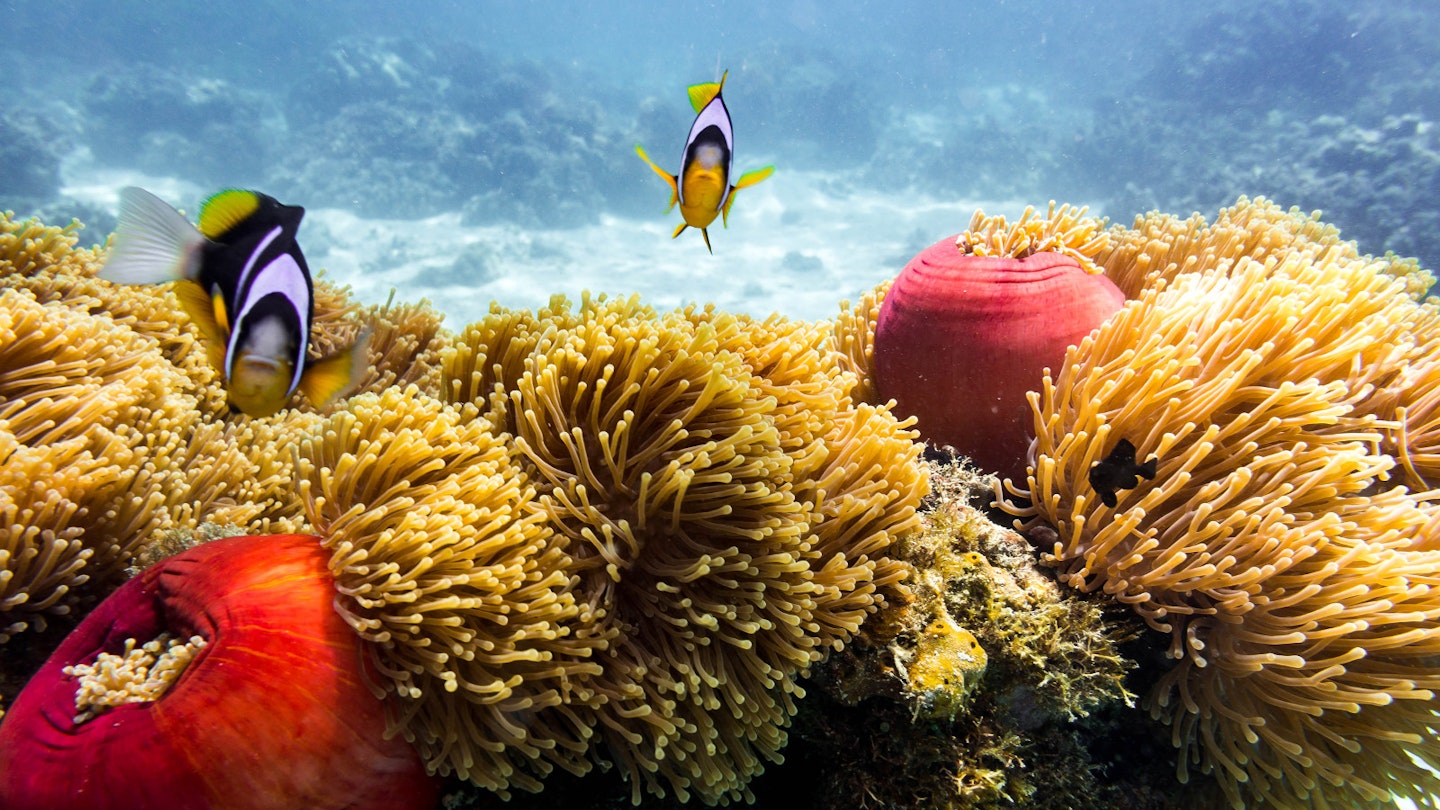Home to a kaleidoscopic array of marine life, the Red Sea boasts some of the world’s most coveted coral gardens, reefs, and sunken wrecks, making it a perfect spot for scuba diving and snorkeling.
With more than 1,000 species of fish and over 200 species of hard and soft coral (including the red-hued reefs that supposedly give the sea its name), exploring its depths guarantees hours of underwater adventure.
The Red Sea is the world’s only tropical sea that is almost entirely surrounded by land. The visibility is outstanding, primarily due to the lack of rivers flowing into it. Bordered by six countries, Aqaba, Jordan, stands out with its unique offerings. It is here that one can find a spectacular marine park located along Jordan’s splendid shoreline.

Aqaba is a compact, mellow seaside destination full of palm-fringed avenues and small markets; a no-frills vibe that captivates visitors. Its location is also perfect for accessing other experiences in the southern tip of Jordan, including Petra and the Wadi Rum desert.
Dive Centres in Aqaba
Diving costs in Aqaba are relatively low, with some of the world’s most trusted dive centres located here. One of the prominent choices is PADI-operating Dive Aqaba, known as the ‘mother of the diving industry’ in this region. With a focus on safety, the team has earned a reputable status, making it ideal for both experienced divers and beginners.
Established nearly 20 years ago by Amjad Sulaibi and Rod Abbotson, Dive Aqaba has a unique history. Rod himself named many of Aqaba’s dive sites and holds the record for the deepest dive in Jordan (167m).

Attraction of Wreck Diving
The wrecks in Aqaba play a pivotal role in attracting divers each year. Notable wrecks include a tank, a plane, and a spectacular ship— all situated just a short distance apart along the beach. The well-preserved Al Shorouk shipwreck at depths between 30 and 60 metres, alongside the more technical dive at the Taiyong shipwreck, presents exceptional diving opportunities. These sunken treasures are often frequented by King Abdullah II of Jordan himself.
Diverse Marine Life
While exploring the vivid hard and soft corals, divers and snorkelers can expect to see a magnificent array of fish species, including parrotfish, clownfish, and lionfish. With a bit of luck, you might also spot seahorses, sea turtles, rays, and moray eels. Life flourishes in the nooks of the wrecks, where starfish, crabs, and shrimps reside.

Accessibility for Divers
My experiences while diving are among the best, whether swimming with green sea turtles in Bali or chasing the sardine run in the Philippines. Notably, the diving in Aqaba Marine Park stands out as the simplest and most varied, thanks to the ease of finding dive sites— more than 23 options await.
For those seeking a prime location within the diving community, several dive hotels and hostels line South Beach, including the Red Sea Dive Center and Darna Village. Otherwise, a short 20-minute taxi ride from Aqaba city can swiftly transport you to the waterfront.
Snorkeling Adventures
The shallow corals within the Marine Park create an ideal environment for snorkeling. During our two-day adventure, we utilized our own gear, opting against wetsuits despite the chilly water for some. Alternatives for equipment rental—including suits and fins—are readily available at a slight extra cost.

We began our underwater escapade at the renowned Japanese Garden, known as Aqaba’s top snorkeling reef. We also drifted over other stunning sites, such as the Rainbow Reef and Seven Sisters, all conveniently located close to each other. The variety of marine life included clownfish, some shy lionfish (while venomous, they often hide beneath corals or within wrecks), pipefish, masked pufferfish, parrotfish, and an impressive humphead wrasse.
With excellent visibility, we explored several wrecks, including ‘The Tank’ and the C-130 Hercules aircraft wreck, the most recent addition having been donated by the Royal Jordanian Air Force.
During our snorkeling adventure, my partner began to free dive effortlessly. He reached depths of five or six metres, gliding past wrecks and even spotting a little lionfish resting in the cockpit of the plane!
Diving Experience
Equipped and ready, we commenced our dive at South Beach. Gently drifting along a luxurious reef, we gradually acclimated. Once comfortable, we made our way to the Cedar Pride shipwreck. Witnessing the ship’s dramatic form emerging from the water was surreal; the vessel, now lying peacefully on its side, has become a thriving habitat for marine life over its nearly 35 years underwater.

One memorable highlight involved diving into the ship’s interior. Our instructor directed us to look up, revealing an air pocket forming a surreal view, as if glancing at the surface through the depths of 16m. Surprisingly, this air remained fresh, thanks to experienced divers who regularly release air from their tanks into this unique bubble formed when the Spanish cargo ship was carefully sunk in 1985.
Optimal Time to Visit the Red Sea
November is considered the perfect time for exploring the Red Sea. Visitors can anticipate exceptional visibility, lower hotel rates, and comfortable temperatures both in and out of the water. Other favorable timeframes extend from late January through May, though this period may experience a surge of divers and increased accommodation prices, alongside the month of October. A minimum stay of a few days to a week is recommended for diving in Aqaba, while snorkelers can enjoy an afternoon to a couple of days.
